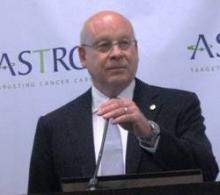ATLANTA – Five common radiation therapy practices are not adequately supported by evidence and may not be the best choice for many patients, radiation oncology experts said at the annual meeting of the American Society for Radiation Oncology (ASTRO).
The evidence-based recommendations on radiation therapy for breast cancer, prostate cancer, and bone metastases are part of the national "Choosing Wisely" campaign, which is aimed at improving the quality of care by reducing or eliminating overuse of tests and procedures. This campaign is about "removal of waste to improve quality and safety, and doing no harm to patients," said Daniel Wolfson, executive vice president and chief operating officer of the American Board of Internal Medicine (ABIM) Foundation, which is leading the Choosing Wisely campaign.
Medical societies in various disciplines have released recommendations geared toward individual clinical disciplines, and now it’s ASTRO’s turn, said Dr. Michael L. Steinberg, chairman of ASTRO’s board of directors, in a briefing announcing the guidelines. "The list serves only as a starting point for a detailed conversation between a patient and physician, and to ensure patient-centered care, which is a core principle of ASTRO."
The five recommendations are:
• Don’t initiate whole-breast radiotherapy as a part of breast conservation therapy in women aged 50 years and older with early-stage invasive breast cancer without considering shorter treatment schedules.
"We’ve known for years that whole-breast radiation improves local control and improves survival, and has cosmetic advantages over mastectomy," Dr. Steinberg said. In recent years, however, randomized clinical trials have demonstrated that shorter courses of therapy – less than 4 weeks, compared with 5 weeks for conventionally fractionated radiation – produce equivalent tumor control and cosmetic outcomes.
• Don’t initiate management of patients who have low-risk prostate cancer without discussing active surveillance.
Patients with low-risk prostate cancer should discuss "reasonable management options" with their physicians, including active surveillance. With this recommendation, ASTRO is "reinforcing the shared decision-making model," Dr. Steinberg said.
• Don’t routinely use extended fractionation schemes (more than 10 fractions) for palliation of bone metastases.
Patients with bone metastases may derive equivalent pain relief from 30 Gy in 10 fractions, 20 Gy over 5 fractions, or even a single 8-Gy fraction, studies suggest. The single-fraction option is more convenient for patients, but it may be associated with a marginally higher need for retreatment of the same site. Patients who are not ambulatory, have transportation problems, or a limited prognosis may be good candidates for the single-fraction option, the guidelines say.
• Don’t routinely recommend proton-beam therapy for prostate cancer outside of a prospective clinical trial or registry.
"There is no clear evidence that proton-beam therapy for prostate cancer offers any clinical advantage over other forms of definitive radiation therapy. Clinical trials are necessary to establish a possible advantage of this expensive therapy," the Choosing Wisely guidelines state.
At ASTRO 2012, investigators reported that men who receive proton-beam radiotherapy for prostate cancer have modestly better bowel function in the short term than do those who receive conformal or intensity-modulated radiation, but the effect is transient. In addition, proton-beam therapy is estimated to cost about 70% more than external-beam radiotherapy for the treatment of prostate cancer.
• Don’t routinely use intensity-modulated radiation therapy (IMRT) to deliver whole-breast radiotherapy as part of breast conservation therapy.
"Clinical trials have suggested lower rates of skin toxicity after using modern 3D conformal techniques relative to older methods of 2D planning. In these trials, the term ‘IMRT’ has generally been applied to describe methods that are more accurately defined as field-in-field 3D conformal radiotherapy. While IMRT may be of benefit in select cases where the anatomy is unusual, its routine use has not been demonstrated to provide significant clinical advantage," the guidelines note.
The cost difference between 3D conformal radiotherapy and IMRT for whole-breast radiotherapy is approximately $7,000, according to Dr. Steinberg.
"These are not ‘never do this’ recommendations, these are ‘engage the patient in the shared-decision paradigm’ guidelines, because there may be patients that are better treated with, let’s say, IMRT [for whole-breast radiotherapy]," he said.
Asked whether the Choosing Wisely guidelines in radiation oncology and other disciplines might be used by insurers to justify denying reimbursement for certain procedures, Mr. Wolfson said that "we haven’t seen that, and whether it comes to be will be the question, but we would sharply criticize that [approach]."


